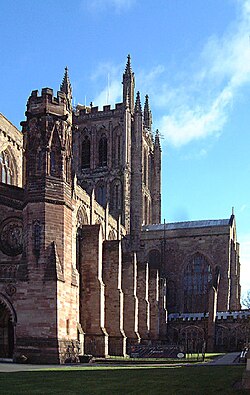Hugh de Mapenor
Hugh de Mapenor | |
|---|---|
| Bishop of Hereford | |
 Exterior view of Hereford Cathedral, where Mapenor is buried. | |
| Elected | 3 February 1216 |
| Term ended | April 1219 |
| Predecessor | Giles de Braose |
| Successor | Hugh Foliot |
| Other post(s) | Dean of Hereford |
| Orders | |
| Consecration | 18 December 1216 by Sylvester, Bishop of Worcester |
| Personal details | |
| Died | April 1219 |
| Buried | Hereford Cathedral |
Hugh de Mapenor (or Hugh de Mapenore; died April 1219) was a medieval
Early life
Mapenor was the son of Robert de Mapenore and his wife Matilda, who lived in Herefordshire at Hampton, Herefordshire near Leominster.[1] Where or how he was educated is unknown, but he was given the title of magister, which implies he studied at some school and attained a degree of education.[2]
Mapenor served William de Braose as a clerk from 1189 to 1196, and then served William's son Giles de Braose, Bishop of Hereford. He occupied the office of Dean of Hereford before 29 September 1202.[3] During his time at Hereford, he was the subject of the Prose Salernitan Questions, which compared his sexual powers to three other clerks. He also served as a judge for the papacy and defended the cathedral chapter in two disputes over the chapter's rights.[2]
When the Braose family fled England in 1208, with Giles going to France and William going to Ireland, Mapenor left also, going to Ireland where he appears as a witness on documents of William de Braose's. It is unclear when he returned to England, but by January 1212 Mapenor was once more in Hereford.[2]
Bishop of Hereford
Mapenor was elected to the
Bicchieri decided the case shortly after the death of John on the night of 18–19 October 1216, in Mapenor's favour. Mapenor gave Stephen Langton, the Archbishop of Canterbury, and Mapenor's ecclesiastical superior, a declaration of obedience on 27 October 1216,[2] and was consecrated on 18 December 1216[4] by Sylvester the Bishop of Worcester.[1]
Although Mapenor's time as bishop was short – just over two years – over 20 of his charters survive. These include a number for
The king employed Mapenor in April as a diplomatic escort, ordering the bishop to bring some of the southern Welsh princes to Woodstock to swear fealty to Henry III. In June of that year, Mapenor attended the consecration of the new
Death
Mapenor died in April 1219, probably on the 16th,[2][4] although older sources give a date of the 13th.[6] He had issued a charter as recently as 14 April 1219. He was buried in Hereford Cathedral. One of his surviving charters documents a licence given to Leominster Priory as alms for the souls of his parents and his predecessor as bishop, Giles de Braose.[2]
Citations
- ^ a b c Barrow Fasti Ecclesiae Anglicanae 1066–1300: Volume 8: Hereford:Bishops
- ^ a b c d e f g h i Barrow "Mapenore, Hugh de" Oxford Dictionary of National Biography
- ^ Barrow Fasti Ecclesiae Anglicanae 1066–1300: Volume 8: Hereford: Deans of Hereford
- ^ a b c Fryde, et al. Handbook of British Chronology p. 250
- ^ Vincent Peter des Roches, p. 166
- ^ Gibbs Bishops and Reform p. 199
References
- Barrow, J. S. (2002). Fasti Ecclesiae Anglicanae 1066–1300: Volume 8: Hereford: Bishops. Institute of Historical Research. Archived from the original on 9 August 2011. Retrieved 26 October 2007.
- Barrow, J. S. (2002). Fasti Ecclesiae Anglicanae 1066–1300: Volume 8: Hereford: Bishops. Institute of Historical Research. Archived from the original on 9 August 2011. Retrieved 26 October 2007.
- Barrow, Julia (2007). "Mapenore, Hugh de (d. 1219)". Oxford Dictionary of National Biography (May 2007 ed.). Oxford University Press. doi:10.1093/ref:odnb/95043. Retrieved 17 February 2009. (subscription or UK public library membershiprequired)
- Fryde, E. B.; Greenway, D. E.; Porter, S.; Roy, I. (1996). Handbook of British Chronology (Third revised ed.). Cambridge, UK: Cambridge University Press. ISBN 0-521-56350-X.
- Gibbs, Marion E.; Lang, Jane (2006) [1934]. Bishops and Reform (Hesprides Press reprint ed.). Oxford, UK: Oxford University Press. ISBN 1-4067-1232-9.
- Vincent, Nicholas (2002). Peter des Roches: An Alien in English Politics 1205–1238 (Reprint ed.). Cambridge, UK: Cambridge University Press. ISBN 0-521-52215-3.
